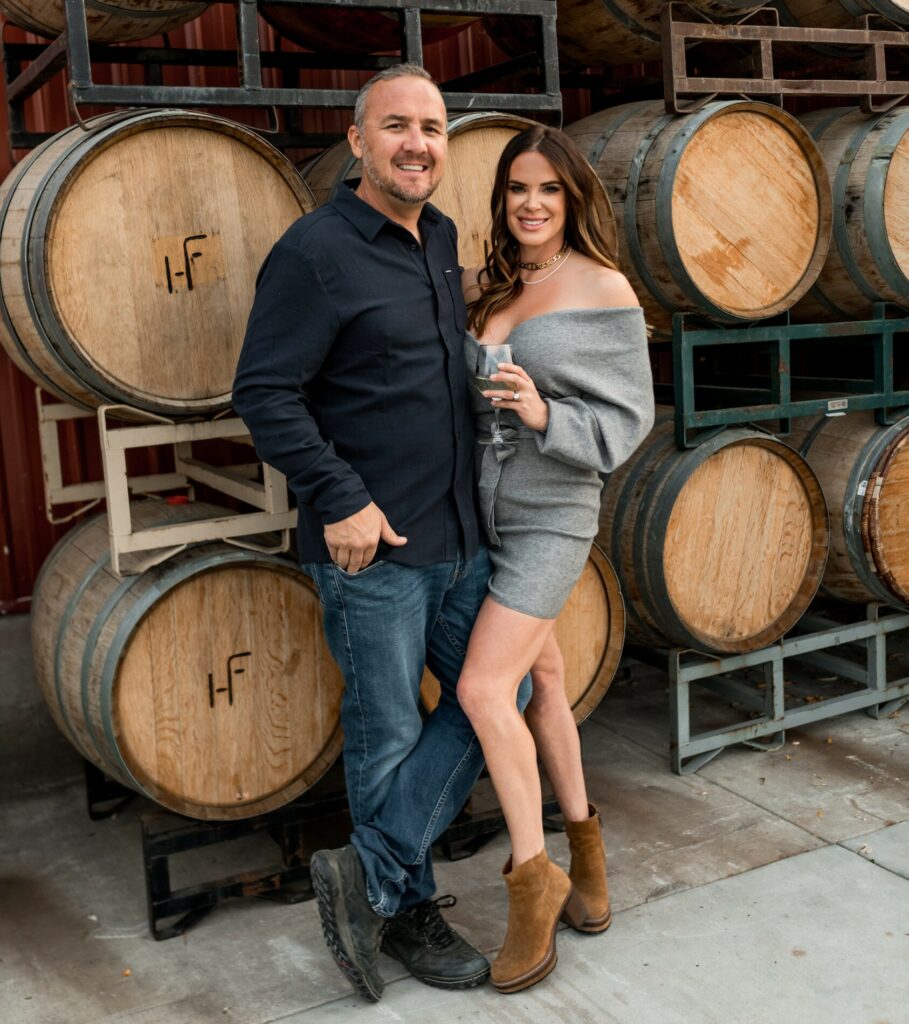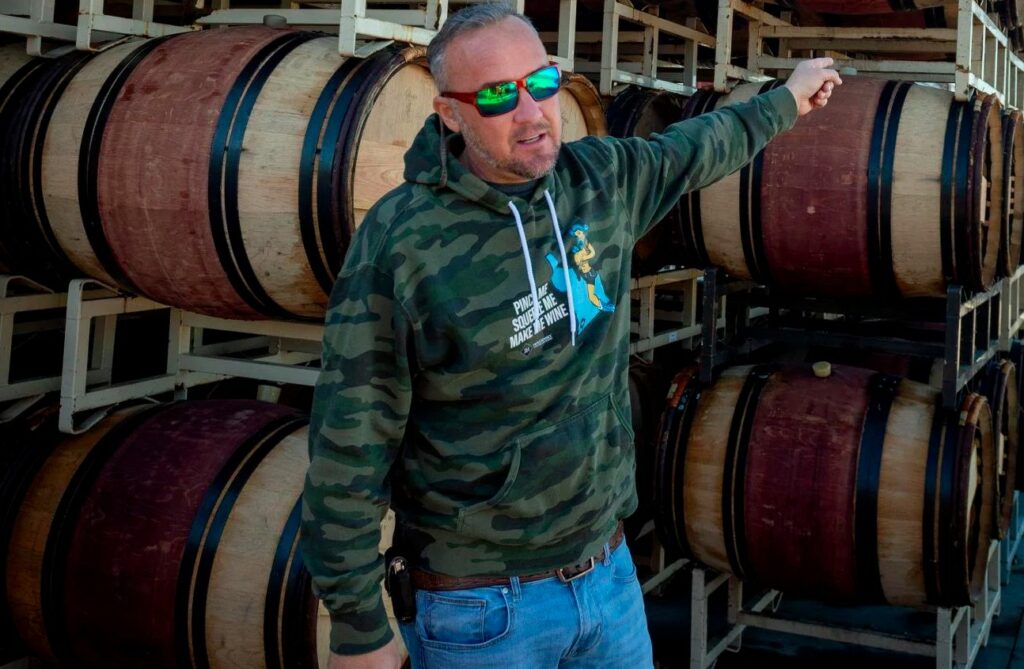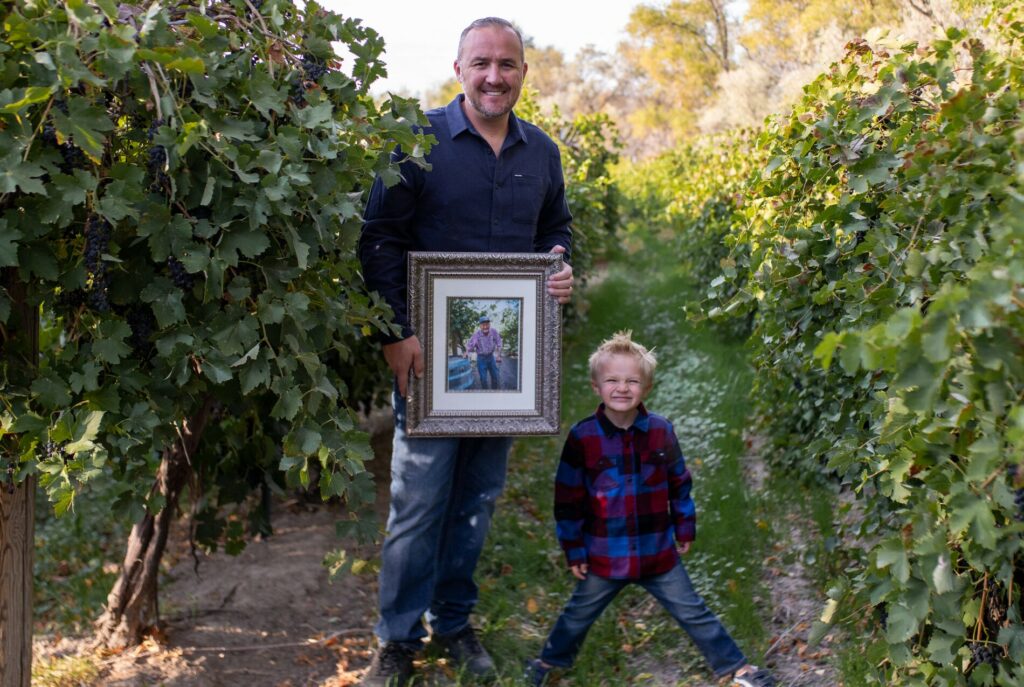
BUHL, Idaho — Last year not only served as the 20th anniversary of James Holesinsky’s eponymous wine program in Idaho’s largely overlooked Hagerman Valley, but it also marked a period of unequaled acclaim for the wines crafted by him and his chemist/wife, Caitlin.
This spring, they are building upon that remarkable momentum as Holesinsky Vineyard and Winery has fun — you know their tasting room team will — as Great Northwest Wine’s 2022 Idaho Winery of the Year.
“We’ve busted our ass to not just make a good product, but make a good product consistently,” he says. “Now, there’s that pressure to keep that pedigree for your brand going.”
Last fall, three times they wowed judges at the Platinum Awards for work with Syrah, earning Double Platinum and 99 points with the Domaine Holesinsky 2019 Gertschen Vineyard Buhljolais Rosé of Syrah ($12) and the Holesinsky Winery and Vineyard 2018 100% JH Syrah ($45).
Their 2020 Sparkling Unicorn ($18) also garnered a Double Platinum and received 94 points. That Buhljolais rosé earned its entry into the Platinum via golds at the 2021 Drink Pink Vino International Rosé Competition and Florida’s American Fine Wine Competition.
At the Idaho Wine Competition, the 2018 CH Syrah received a double gold and picked up a gold medal at the Women’s International Wine Awards, gaining access because it is among the projects of Caitlin Holesinsky — hence the “CH” reference. Ironically, the 2018 JH Syrah, as in James Holesinsky, only received a gold medal at the Idaho judging. There were also golds awarded to the 2020 IdaPeach Sangria and 2020 Unicorn.
The first Holesinsky Platinum came in 2020 for the 2018 Pinot Noir. Last spring, their 2019 Pinot Noir earned a gold at the Cascadia International, adding another layer of support for their winemaking while also displaying the versatility of their site.
The 2020 Billy Brew, which features Chardonnay and peaches from old-growth orchards, grabbed gold at the Cascadia and Savor NW Wine Awards. That Cannon Beach judging also returned a gold for the 2008 Port Hoser, a fortified bottling of classic Portuguese varieties that spent 12 years in barrel.
Platinum winners grown at 3,770 feet altitude

James Holesinsky quickly came to embrace the uniqueness of the site he grew up on — west of Twin Falls and much closer to Nevada than Boise or Sun Valley — beginning with its elevation. At 3,770 feet above sea level, his vineyard along the Snake River canyon rim is several hundred feet higher than those near the Idaho/Oregon border. Based on research by Great Northwest Wine, Holesinsky Vineyard is believed to be the loftiest commercial vineyard in the Pacific Northwest.
As a tribute to his chemist-turned-farmer father, James established the vineyard in 2001 with Chardonnay. The next year, the son added Syrah, Merlot and three Port-style varieties — Sezão, Tinta Cão and Touriga Naçional. After a few years, he planted Cabernet Sauvignon, Riesling and then Muscat as he transitioned his father’s land from a dairy farm to a winery, sourcing primarily from their estate vineyard but also some in nearby Hagerman.
“Everyone thought I was crazy by planting Syrah,” he says.
Holesinsky took the chemistry that he learned from his father and, at the age of 21, enrolled into the University of California-Davis program for winemaking. One of his instructors was renowned geneticist/winemaker Carole Meredith.
“She told me, ‘Wow, James, you are kind of a kook,’ ” he chuckles. “I was 21 with long hair and played bass in a band. I was just a kid going to Primus and Phish shows, but I learned cleanliness is next to godliness and other very good things. I’m not a wild yeast kind of guy, though. And while I am certified organic, I do add sulfites to my wines.”
The uniqueness of his site, his penchant for organics and his business — Clear Lakes Products — took him down a path to a program that fit his approach.
“I was making wine but also building a large chemical company that financed my equipment,” James says. “And what we need to do to get our fruit to shine in this region starts with treating the vineyards like athletes where you put them in the right position to win. And fortunately, I have no loans. We own everything.”
So. Oregon grad joins Holesinsky in lab, winery, life

It would seem that a turning point in the success of Holesinsky’s wines took a major step when he met the love of his life — Caitlin. The native of Alaska earned a degree in biomedical science from Southern Oregon University in 2015 and developed an interest in the region’s wine industry along the way. She planned to go into pharmaceutical research, then met James through a mutual friend during a trip to Idaho. Their shared interests include snowboarding and boating. Within three months, they were engaged.
“It was love at first sight,” she says, “and what he did — the wine and chemistry — was interesting to me as well.”
Clear Lakes produces disinfectants, soaps and other agents for the dairy industry and other agricultural purposes such as horse supplements and lotions.
“When I arrived, we had five wines,” she said. “We were both involved in Clear Lakes, but I stepped away from that when I had our son and decided to help with the winery and handle the marketing. Now that we’re getting close to 30 different wines, there’s a lot more to do.”
It’s a good thing that James doesn’t list many hobbies.
“The winery isn’t work for me,” he says. “It might be playing in a basketball league, the golf course or shooting a gun for another dude, but I love being a viticulturist, and I love winemaking.”
Along the way, the Holesinskys also elevated the profile of Clear Lakes. Their company in nearby Filer helped the community in the early days of the pandemic by creating hand sanitizer. Ordinarily, Clear Lakes would make 500 gallons of sanitizer in a month. At one point of the pandemic, the Holesinskys ramped up production to 5,000 gallons per day and operated a drive-thru to help first-responders and their community.
The Holesinskys are proud of their organic approach to viticulture, which includes abstaining from synthetic herbicides and fertilizers. Their silica-laden volcanic soil features rhyolite and is accompanied by basalt and breccia rock. The Lake Bonneville flood led to loam soil loaded with potassium, setting the table for wine grapes that boast elevated levels of acidity while still containing high pH. Those conditions helped the Hagerman Valley earn its reputation for producing some of the nation’s best watermelon in the early 1900s.
“We’ve done a lot of improvements in our vineyard management and developed our own trellising systems,” James says. “We’re hanging our Chardonnay at 12 tons per acre (in Oregon, it’s much closer to 3 tons per acre) and when we use stainless steel it comes through so clean and so rich with almost Sauvignon Blanc-like flavors. So we’ve developed our own style with it.
“It also helps that we’ve invested in a new refrigeration system so that I can really manage the fermentation of the white wines,” he added. “We’re really trying to go to the next level.”
The Holesinskys now bring in Malbec from Kerry Hill Vineyard, an organic, bee-friendly site west of Caldwell. Gewürztraminer also is part of the non-estate program, yet they’ve recently purchased 150 acres next to their winery and are using geothermal water without a drip system to irrigate. In some respects, it might be easier to buy Syrah from Washington state, and the Holesinskys were given that offer.
“We’re not interested in fruit that’s not from Idaho,” he says. “About 90 percent of what we produce is from the Hagerman Valley.”
Holesinskys to bottle 14,000 cases from bountiful 2021

While the vast majority of Northwest vineyards reported smaller crops because of winter damage and the June “heat dome,” the 2021 vintage told a different story for Holesinsky.
“We brought in 140 tons last year, and we were maxed out,” he says. “While everyone was struggling, our vineyards never produced more because of our trellising system and our own way of pruning. It’s worked out well despite the pandemic.
“Our growth has taken us from over 10,000 cases to 14,000 to 15,000 cases,” he added. “And we’re selling everything out of our tasting room and in Boise. We’re not taking on any more wholesale business.”
Interestingly, they adjust their marketing approach based on the style of the wine and the audience. For example, there is the Domaine Holesinsky brand for the 2019 Gertschen Vineyard Buhljolais Rosé of Syrah. It’s a white label that’s along the lines of what you might expect to see from an Old World producer, and it’s a look that particularly appeals to Sun Valley consumers who might otherwise not pay attention to an unknown Idaho brand.
On the other hand, there’s the clear bottle featuring a fanciful pink unicorn rearing up on the front of the Sparkling Unicorn Rosé of Syrah. Inside, its serious side showed with golds at the prestigious Sunset International Wine Competition, Drink Pink Vino International Rosé Competition and the American Fine Wine Competition. Billy Brew, named for their dog, is a low-alcohol Chardonnay that’s co-fermented with peaches, presents as slightly fizzy and comes sealed with a crown cap.
Then there’s the case of the IdaPeach program. The Holesinskys hear the criticism surrounding the label for that wine, yet the blend of Chardonnay and peach has a significant following, which explains its 3,000-case production — one of the largest bottlings in the Idaho wine industry — its spot on shelves of Albertsons and on-tap support in Boise. Few can deny that it’s delicious; there’s balance to the off-dry approach, and the price is $14. The red version, with a similar production level, is $16.
“Those IdaPeach Sangrias are great introductory wines for people who are not wine drinkers,” Caitlin says. “Too many people think wine is pretentious and snooty.”
And the Holesinskys quickly point out their IdaPeach brand — featuring a young woman dressed akin to Daisy Duke holding an oversized peach in front of each breast — was created by a fun-loving breast cancer survivor. Interest in IdaPeach prompted the Holesinskys to create a line of merchandise around that brand.
“I’ve only had one person tell me they thought it was sexist, that it was ridiculous and they didn’t want to sell any of our other wines because of it,” Caitlin says. “What many people don’t realize is that James is the only man in the company. It’s an eye-catching bottle, and we’re fun. We’re not stuffy. We’re approachable, and that’s who we are. And we’re selling 6,000 cases of those wines at around $17 a bottle.”
Family works on petition for 1,000 Springs AVA

While the wines are serious, there typically is levity surrounding the Holesinskys. Their Liquid Quack Sparkling Moscato is another example. Its Facebook campaign features the Holesinsky family’s pet duck — Mr. Quackers — and there’s a bubbly version of the IdaPeach now.
“We’re trying to bridge that gap with some things,” James says.
The success of Holesinsky Vineyard and Winery comes down to the terroir, the organic approach and their shared backgrounds in chemistry. They hope the growing acclaim for their program — originally inspired by James’s late father — will help with their petition to the federal government to establish the 1,000 Springs American Viticultural Area. A research paper on the Bonneville flood, authored by James’s sister, will be the centerpiece to their proposal to create another sub-AVA of the Snake River Valley and serve as a memorial to Frank, who died in early 2020.
Time will tell if Frank’s grandson, Henrik, who will be 5 this year, is in line to pick up for his mom and dad someday.
“He already has quite the palate,” Caitlin says.
- Holesinsky Vineyard and Winery, 1498 Valley Steppe Drive, Buhl, Idaho 83316, Holesinsky.com, (208) 539-8360.

I have been trying to order wine from you for awhile now and the site will not let me go any further than putting in my address. I just want to place an order for Ida Peach Pouches. Please let me know how I can do this
Greetings, Katen.
Here is the link to the contact us page for Holesinsky Vineyard & Winery.
https://www.holesinsky.com/contact-us
Here is the phone number to the tasting room:
208 539 8360
Sincerely,
Eric